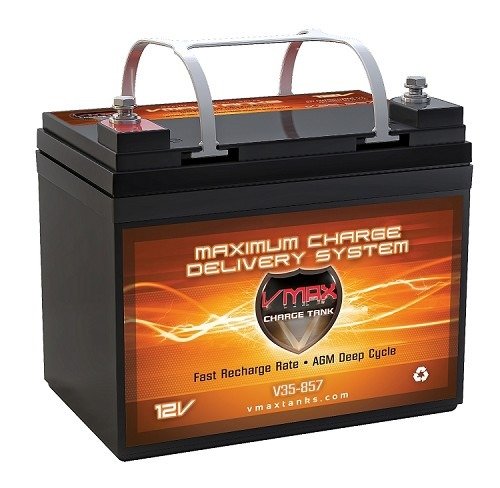An AGM battery is fully charged at 12.8 to 13.0 volts, 50% charged at around 12.2 volts, and considered discharged below 12.0 volts. This voltage-based measurement is one of the simplest and most accurate ways to check the health and state of charge (SOC) of your AGM (Absorbent Glass Mat) battery—without guesswork. Whether you’re maintaining a solar battery bank, RV power system, or backup UPS, knowing how to interpret voltage readings can prevent unexpected failures and extend battery life.
Most people want a quick, reliable way to know when their battery needs charging—or replacement. That’s exactly what this guide delivers. With clear voltage thresholds and easy-to-read tables, you’ll never be left wondering whether your AGM battery is healthy, half full, or nearly dead.
Stick around—we’re not just giving you a chart. We’ll explain what the numbers mean, when to take action, and even recommend the best tools and batteries to use.
Best AGM Battery for Accurate Voltage Monitoring and Long-Term Use
If you’re looking for the best AGM battery to monitor using a voltage chart, these three top-rated options stand out for their reliability, durability, and real-world performance. Whether you’re powering a solar system, RV, or emergency backup, these AGM batteries offer consistent voltage readings that make monitoring simple and accurate.
Optima Batteries 8016-103 D34M BlueTop Starting and Deep Cycle Battery
Why we picked it: This dual-purpose battery is ideal for deep cycling and cranking power, delivering steady voltage under demanding conditions—perfect for boats, RVs, or off-grid systems.

VMAXTANKS VMAX V35-857 12 Volt AGM Battery
Why we picked it: Compact, durable, and powerful—this battery holds voltage longer and recovers well from deep discharges, making it ideal for solar or trolling motor setups.

Renogy Deep Cycle AGM Battery 12 Volt 100Ah
Why we picked it: Designed specifically for solar applications, it offers low self-discharge and stable voltage output, making it perfect for off-grid users monitoring SOC by voltage.

What Is a Normal Voltage for an AGM Battery?
A normal voltage for a fully charged 12V AGM battery ranges between 12.8 and 13.0 volts at rest. This voltage is a key indicator of battery health and charge level when measured with no load and after the battery has rested for several hours.
Understanding these voltage levels can help you prevent deep discharges, catch early signs of battery failure, and make smarter charging decisions. Here’s a breakdown of typical readings:
- 12.8V – 13.0V: Fully charged
- 12.4V – 12.7V: 75–90% charged
- 12.2V – 12.3V: 50% charged
- 12.0V – 12.1V: Low charge, recharge soon
- Below 12.0V: Discharged—can damage the battery if left uncharged
- 10.5V or less under load: Battery is likely faulty or needs replacement
It’s important to measure your battery when it’s been at rest (no charging or discharging) for at least 4–6 hours. Surface charge from recent charging can cause falsely high readings. Similarly, recent loads can cause temporarily low voltages.
In cold climates, voltage may read slightly lower, while warm temperatures can cause slightly higher readings. Always refer to your manufacturer’s guidelines if available, but the chart above gives an accurate rule of thumb for most AGM batteries.
Pro tip: Using a high-quality digital multimeter or battery monitor can give you more precise readings than analog meters, especially when trying to identify early signs of wear.
How Can You Use a Voltage Chart to Determine Battery Health?
An AGM battery voltage chart helps you quickly determine how charged—or discharged—your battery is, just by reading the voltage. It’s an essential tool for identifying potential issues before they turn into bigger problems, especially if you’re off-grid or rely on consistent power supply.
The key is to test the battery when it’s at rest, meaning it hasn’t been charged or discharged for several hours. This gives you the most accurate voltage reading, unaffected by surface charge or load.
Below is a standard AGM battery voltage chart for a 12V system:
AGM Battery Voltage Chart (12V at Rest)
| State of Charge | Voltage (12V Battery) | Voltage (6V Battery) |
| 100% Charged | 12.8 – 13.0 V | 6.4 – 6.5 V |
| 90% Charged | 12.6 – 12.7 V | 6.3 – 6.35 V |
| 75% Charged | 12.4 – 12.5 V | 6.2 – 6.25 V |
| 50% Charged | 12.2 – 12.3 V | 6.1 – 6.15 V |
| 25% Charged | 12.0 – 12.1 V | 6.0 – 6.05 V |
| Fully Discharged | Below 12.0 V | Below 6.0 V |
You can use this chart to:
- Check charge level before using or storing a battery
- Avoid over-discharging, which shortens battery life
- Confirm if the battery needs charging or replacement
- Troubleshoot performance issues in power systems
Tip: Pair this chart with a digital multimeter to measure resting voltage every few weeks, especially if the battery is in storage. If your voltage regularly drops below 12.0V, it’s time to recharge or replace.
What Causes Voltage Drops in AGM Batteries?
Voltage drops in AGM batteries usually result from natural discharge, poor charging habits, parasitic loads, aging cells, or internal damage. Understanding the causes helps you prevent premature failure and maintain reliable power.
Common Causes of Voltage Drops:
Self-Discharge Over Time
AGM batteries naturally lose charge even when not in use. Though slower than flooded batteries, an unused AGM can still drop below 12.0V in a few months if not maintained.
Parasitic Loads
Small devices like onboard electronics, clocks, or GPS systems can slowly drain your battery, especially in RVs, boats, or stored vehicles. These constant draws can lower voltage without you noticing.
Undercharging or Overcharging
Improper charging is a major culprit. Undercharging prevents the battery from reaching full capacity, while overcharging (especially without smart chargers) can lead to overheating and plate damage, reducing voltage retention.
Battery Age and Wear
As AGM batteries age, internal resistance increases and capacity declines. A battery that once held 12.8V at full charge may now settle at 12.5V or lower, even with proper charging.
Temperature Extremes
Cold weather can temporarily reduce voltage readings and performance. Heat, on the other hand, speeds up chemical degradation, which permanently lowers voltage-holding ability.
Sulfation or Internal Shorting
If an AGM battery drops below 12.0V frequently and struggles to hold a charge, it could be suffering from sulfation or internal short circuits—often irreversible.
Pro tip: Keep your battery on a smart trickle charger during long storage periods to avoid gradual voltage loss and capacity fade.
How Do You Measure AGM Battery Voltage Accurately?
To measure AGM battery voltage accurately, use a digital multimeter or a battery monitor, and always test when the battery is at rest. This ensures you get a true reading of the battery’s state of charge.
Here are the most reliable methods for measuring AGM battery voltage:
Digital Multimeter (Most Common and Affordable)
Step-by-Step:
- Set your multimeter to DC voltage (20V range for 12V batteries).
- Connect the red probe to the positive terminal and the black probe to the negative.
- Read the display—values between 12.8V and 13.0V typically indicate a full charge.
Accuracy Tips:
- Test after the battery has rested for 4–6 hours with no load or charging.
- Use a calibrated meter to avoid false readings.
Battery Monitor (Long-Term Monitoring)
- What It Is: A permanently installed device that tracks voltage, current, and SOC (state of charge) in real-time.
- Best For: RVs, boats, solar systems, or any setup where consistent monitoring is needed.
- Examples: Victron BMV-712, Renogy 500A Battery Monitor.
- Benefits:
- Tracks historical performance.
- Sends alerts when voltage drops below safe levels.
Smart Chargers with Voltage Display
- Some smart AGM chargers display real-time voltage while charging or maintaining the battery.
- Use them to check: charging voltage (usually 14.4–14.7V for AGM) and float voltage (13.2–13.5V).
- Good as a backup tool when a multimeter isn’t handy.
Load Testers (Voltage Under Load)
- These simulate a real-world load on the battery to see how the voltage holds up.
- While not purely for voltage reading, they provide valuable insight into battery health.
- Note: Voltage may temporarily drop during the test—compare this to resting voltage for full analysis.
Quick Tips for Accurate Measurements:
- Always test at rest for true voltage.
- Avoid measuring right after charging.
- Clean battery terminals for consistent contact.
- Test in a stable temperature environment (room temperature is ideal).
When Should You Replace an AGM Battery Based on Voltage?
You should replace an AGM battery when it consistently holds less than 12.0V at rest, even after a full charge. This indicates it can no longer maintain an adequate state of charge, which affects performance and reliability.
Voltage alone isn’t the only indicator, but it’s one of the most accessible and accurate early warning signs. Here’s how to interpret the numbers and make the right call:
Signs It’s Time to Replace Your AGM Battery
- Resting Voltage Below 12.0V
If your battery consistently drops below 12.0V and doesn’t bounce back after charging, the internal chemistry may be degraded beyond recovery. - Voltage Drops Quickly Under Load
A healthy AGM battery should maintain stable voltage under use. If voltage falls rapidly during light use, the battery’s internal resistance is likely too high. - Fully Charged but Still Low Voltage (Below 12.4V)
If your charger says the battery is full, but the voltage reads 12.3V or lower, it’s a red flag. The battery is no longer capable of holding a full charge. - Unusual Behavior During Charging
Signs include:- The charger stays in bulk charge mode for too long.
- Charger fails to switch to float mode.
- Battery heats up unusually during charge.
- Sitting Idle Drops Voltage Fast
Healthy batteries can sit unused for months and still hold a decent charge. A fast voltage drop means either parasitic drain or chemical deterioration.
Don’t Wait Too Long
Continuing to use a weak AGM battery can damage connected electronics or leave you stranded. Replace it promptly to avoid system failures—especially in critical applications like RVs, boats, or solar banks.
Conclusion
Understanding AGM battery voltage is essential to maintaining performance, safety, and battery lifespan. A fully charged AGM battery should read around 12.8V to 13.0V, and knowing how to read and interpret this number can save you from unexpected failures.
Always remember: battery maintenance starts with observation. A simple voltage check every month can extend your battery’s life by years and keep your equipment running smoothly.
Frequently Asked Questions About AGM Battery Voltage Chart
What voltage is too low for an AGM battery?
Any reading consistently below 12.0 volts at rest is considered too low. It indicates the battery is deeply discharged or nearing the end of its life. If it drops below 10.5V under load, it’s likely damaged and may no longer be reliable.
Can I revive an AGM battery with low voltage?
Sometimes, yes—if the battery hasn’t been sulfated too badly. Use a smart charger with a reconditioning mode or trickle charge it slowly. However, if voltage remains low after charging or drops quickly again, replacement is the best option.
How do I know if my AGM battery is fully charged?
A fully charged AGM battery should rest at 12.8V to 13.0V after being off the charger for a few hours. Smart chargers usually indicate “full” when the battery reaches a set voltage and minimal current is drawn.
Is it safe to charge an AGM battery below 12V?
Yes—but only with a charger designed for AGM batteries. Do not use high-amp jump starters or traditional chargers, as they can overheat or damage the internal components. A slow, controlled charge is best.
How often should I check my AGM battery voltage?
For vehicles or equipment in regular use, check once a month. For stored or infrequently used batteries, check every 2–4 weeks or connect a battery maintainer to keep voltage steady.